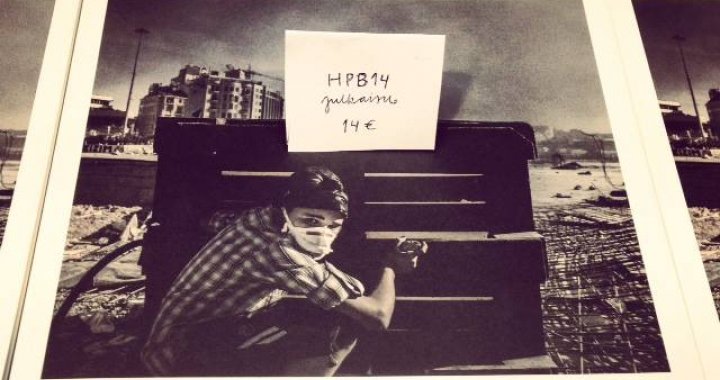
Q&A with Tiina Salmia, Producer of the Helsinki Photography Biennial
21/03/2014
Helsinki Photography Biennial
Helsinki, Finland
March 27 - May 14, 2014
Helsinki Photography Biennial is a series of events on photo/lens-based contemporary art, organized every two years in spring. 2014 Helsinki Photography Biennial is produced by Union of Artist Photographers/Photographic Gallery Hippolyte in collaboration with The Finnish Museum of Photography.
This year, the biennial aims to examine causal relations regarding ecological issues.
The biennial will be curated by Basak Senova, a curator and designer based in Istanbul. Basak Senova’s curatorial framework addresses fallacies of ecological knowledge and fosters collaborative connections between ecological data and photography-based archives. Throughout the course of this process, archives will be the essential tool of the biennial.
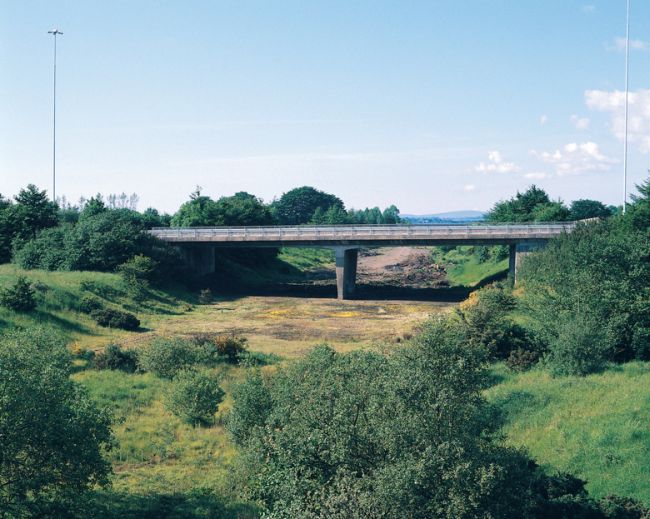
Mary McIntyre. The Construction of a Utopian Model, 2000
Speaking with Arterritory was Tiina Salmia, producer of the Helsinki Photography Biennial:
The theme of 2012 Helsinki Photography Biennial was urbanity and the city. Did that subject then lead to this year's theme – to examine causal relations regarding ecological issues? Please tell us more – what are these “ecological fallacies” that the Biennial will be covering?
The biennial has a committee (consisting of members of the Union of Artist Photographers) that starts brainstorming on a theme for the next biennial soon after the previous biennial has ended.
When they decided that the theme of the 2014 Helsinki Photography Biennial should be causal relations related to ecological questions, the next logical step was to invite the Finnish Mustarinda Association to develop it. Mustarinda is in the vanguard of its field, promoting ecological and cultural diversity, and the position of various fields of arts and sciences.
One of the most important goals in the organizing of the Helsinki Photography Biennial has always been the importing of new impulses to the field of Finnish photography. Therefore, Curator Basak Senova from Istanbul offered fresh perspectives to the biennial from the moment we met her, and has expanded the horizons of the event in an interesting way.
Senova has processed the theme and came up with the concept of Ecological Fallacy, which refers to the term “the ecological fallacy in statistics”. It is a logical error or a mistaken assumption in the interpretation of statistical data. Derived from this analogy, the biennial questions analogous errors and assumptions, which are deliberately and systematically made by the ruling powers that violate the ecological balance of the world. In this context, Basak Senova’s curatorial framework addresses fallacies of ecological knowledge and fosters collaborative connections between ecological data and photography-based archives.
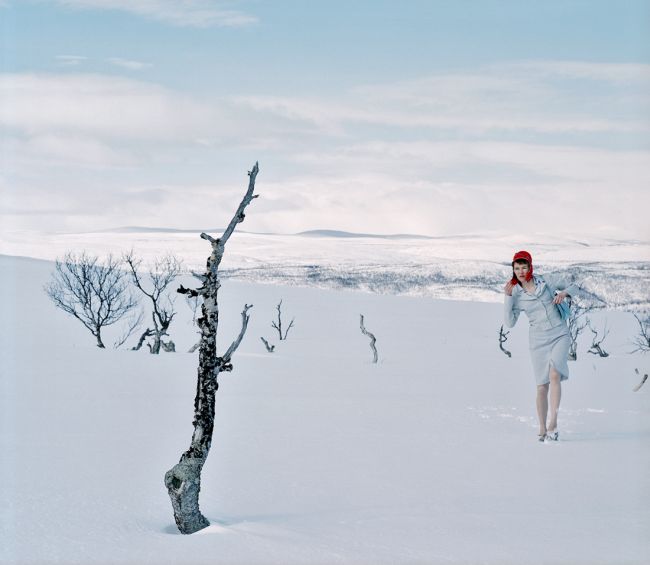
Marja Helander. Palopää, 2001. © Marja Helander
More about the Biennial process – did the curator choose which artists to work with, or did she select among a selection of already accomplished works?
Has the curator chosen the artists participating in the biennial? Yes, Basak Senova’s Ecological Fallacy exhibition features 19 projects from artists around the globe.
Mustarinda’s Objects on Oil presents 4 artistic research processes:
1.The Archive – researcher of economic culture Paavo Järvensivu, researcher of literature Karoliina Lummaa, Anna-Kaisa Rastenberger (curator, The Finnish Museum of Photography) and Sofia Lahti (amanuensis, The Finnish Museum of Photography); 2. Architecture – architect Martti Kalliala and writer Jenna Sutela; 3. The Forest – artists Guy Ben-Ner and Ilkka Halso; 4. Energy – visual artists Jussi Kivi, Antti Majava and Nestori Syrjälä, and philosopher Tere Vadén.
Can you describe the Photography Biennial – its design, content structure, etc?
This is how Curator Basak Senova describes her exhibition designs in the Helsinki Photography Biennial Publication:
The spatial and structural design of the “Ecological Fallacy” exhibition in the Finnish Museum of Photography is structured around the idea of linking different artistic methodologies, attitudes, and critical approaches on the mechanisms underlying ecological catastrophes. Accordingly, each work is presented by claiming its own territory – subtle divisions through the use of background colors and walls. Each work is accompanied by brief info notes that have been placed at a certain distance from the work and that facilitate navigation through the exhibition by being recurring design elements. The navigation structure enables the viewer to choose his/her own path in the exhibition. Barbaros Kayan’s oversize photograph on the façade of the museum’s building looks over the street and the quad of the Cable Factory.
The function of the Photographic Gallery Hippolyte iss to depict the “framed” ideological and historical side of the biennial. In this sense, the design aims to utilize the architectural characteristics of this historical venue. Various form-based, functional, and acoustical parameters are modestly resolved in the design, which is based on simplicity.
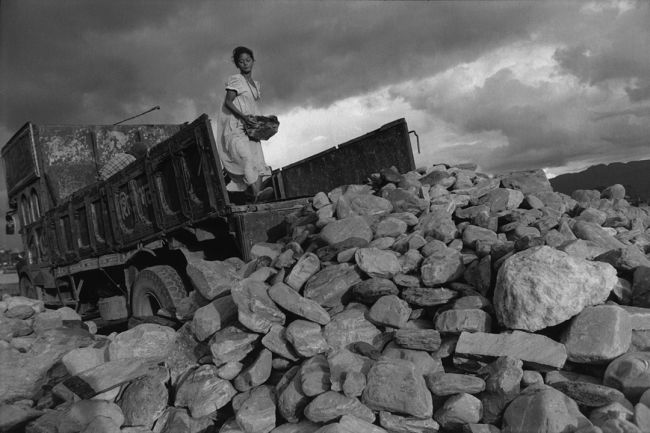
Olof Jarlbro. Stone Factory, 2011
The L3 Warehouse in Jätkäsaari is an evident sign of the gentrification process that the city of Helsinki is undergoing. In this respect, the building inhabits works that process different aspects of urban developments and the imposed political, cultural, economical, and social conditions in different geographies. No major architectural intervention has been applied to the space for the purpose of keeping the identity of the building in its raw state, which is naturally in dialogue with the works.
The front windows of Galleria U are all covered with images of Tamás Dezső – as a layer that has a direct connection to the city. Only mobile walls in the gallery are used to present the framed photographs of Dezső, without any further modification to the gallery. The existing walls have been kept as a blank background for this spatial installation.
Kaisa House is occupied by the research-based work of Tuula Närhinen. The work has been placed among the existing furniture of the library.
Daniel G. Andújar’s postcards, which are distributed in all of the main venues, function as a repeated design element and suture that links the venues to one another.
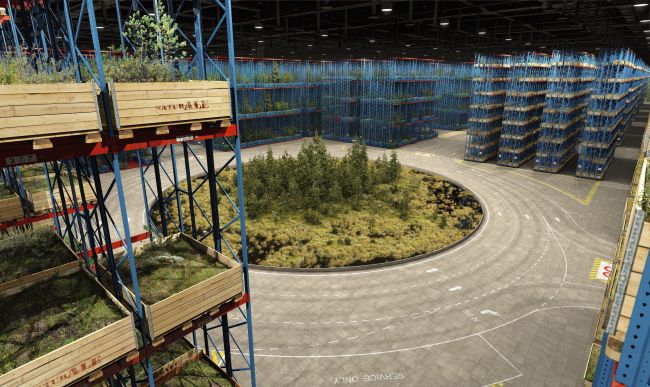
Ilkka Halso. Roundabout, from the series Naturale (2011–). © Ilkka Hals
Please give us five Biennial highlights that one should not miss.
In addition to the extremely interesting Ecological Fallacy + Objects on Oil Exhibition, curated by Basak Senova and the Mustarinda Association in The Finnish Museum of Photography and Photographic Gallery Hippolyte, which I absolutely recommend, a person visiting Helsinki shouldn’t miss the following HPB Events:
Barbaros Kayan’s “Occupy Taksim” project will be presented at the Helsinki Central railway station, The Finnish Museum of Photography and Restaurant Hima & Sali at the Cable Factory;
The exhibition at L3, an abandoned port warehouse in Jätkäsaari;
HPB14: Ecological Fallacy + Objects on Oil Seminar, which will be held on Saturday March 29, 11 AM – 4 PM at Restaurant Hima & Sali;
HPB14 Publication, which doubles as a special issue of Mustarinda Magazine, and which discusses and deepens the theme of the biennial;
Tuula Närhinen’s Baltic Sea Plastique Exhibition at Helsinki University's Main Library (Kaisa House), from March 27 until May 14, 2014. Environmental issues that have been important to Tuula Närhinen’s work in the past are also present in this exhibition. This multi-piece installation draws attention to human-created marine debris and its devastating effects on the marine ecosystem. The name of the installation, “Baltic Sea Plastique”, refers to the plastic waste along our own home shores of the Baltic Sea.